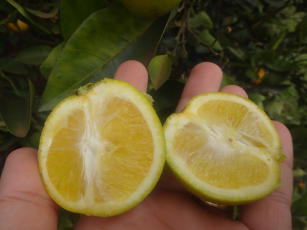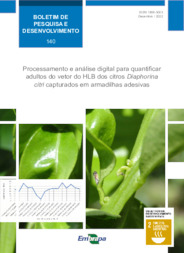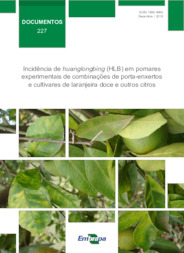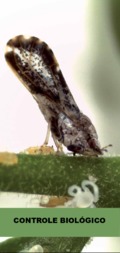Research proposes regional control of insect vector to improve fight against citrus HLB
Research proposes regional control of insect vector to improve fight against citrus HLB
A study by Embrapa and international partners should inform changes in regulation from the Brazilian Ministry of Agriculture, Livestock and Food Supply (Mapa) to improve the control of Huanglongbing (HLB), or greening, currently the most severe citrus disease identified in Brazil, in the states of São Paulo, Minas Gerais and Paraná. In this research work, the scientists recommend the adoption of measures to control the insect vector, the Asian citrus psyllid (Diaphorina citri).
Mapa's Regulatory Instruction no. 53, from October 16, 2008 (or IN 53/2008, from the acronym in Portuguese), establishes measures to contain the disease, but it does not address, for instance, the control of the insect vector, which is essential so that HLB does not spread at a regional scale.
“The research is fundamental to generate technical knowledge for Mapa's decision-making. We completely agree with this study. Controlling the HLB vector is essential to contain the disease. We have to find the legal means to include this action during the review of IN 53/2008”, asserts the general coordinator of Plant Protection from the Department of Plant Health, within Mapa's Secretariat of Agricultural Defense, Pablo Parizzi.
He adds that the review of IN 53/2008 is a priority of the Plant Protection Coordination. “We hope that this year a working group will be formed by institutions involved in HLB research and control, such as Mapa, Embrapa, Citrus Croppingi Defense Fund (Fundecitrus) and state agricultural defense agencies, which can start the works of reviewing the norm, and certainly the results of this research will be discussed”, states the coordinator from the ministry.
The research is the theme of a paper recently picked as Editor’s Choice by Journal of Applied Ecology,English periodical focused on disseminating research results that are applied in interventions related to ecological aspects.
“[This study] is a great example of applied ecological work that relates directly to specific regulation”, affirms the senior editor of the periodical Phil Stephens in their analysis of the article “Grower and regulator conflict in management of the citrus disease Huanglongbing in Brazil: A modelling study”.
After establishing a panorama of the impacts of the disease in several countries, Stephens reports that, in 2008, the Brazilian government issued a regulatory instruction that determines the removal of symptomatic trees at quarterly intervals and that any production unit with at least 28% of trees with symptoms must be completely removed. He also underscores that the regulation caused conflict with growers, because even symptomatic trees can produce, and thus many growers would prefer not to remove them.
Based on biomath tools, the authors of the paper, which include the researcher from Embrapa Cassava and Fruits Francisco Laranjeira, coordinator of Plant Health portfolio, demonstrates that the aspects of the regulatory instruction, aimed at individual orchards, would not work at a regional scale. They propose better types of management to reduce plant infections and thus prevent losses of income for growers.
Removing the sick plant is not enough
“With this work, we managed to show that there is a conflict in determining to remove all the plants of the orchards with over 28% of symptomatic plants from time to time, as the regulatory instruction establishes. Because if you remove a symptomatic plant that is still producing, that can not be good for growers, but leaving it in the field, it will become a source of HLB propagation in the region. That is, it is not good for the disease control either. Despite that, in the case of younger plants, they are worth removing. In a regional scale, we have demonstrated that this is not enough [to control the disease]. Reducing the insect-vector population is necessary. The regulatory instruction only discusses the plant and is omissive regarding the vector”, Laranjeira explains.
In the article, the authors make several considerations aimed at improving the regulatory instruction, such as, for instance, incentives to the implementation of regional management areas. The scientists are against the limit to remove an entire production unit. Instead, they defend a combination of spraying the area (to reduce the population of the vector) with the removal of symptomatic trees. If the spraying results in reduced infection, less trees will have to be removed, a more acceptable situation for growers.
“Let us say that the disease reaches the state of Sergipe. According to the regulatory instruction, the state plant defense agency should advise growers to remove the plants. They would have to quickly remove them and lose everything, if the insect-vector population in the area is not reduced”, Laranjeira explains.
According to him, the study demonstrated that there is no use of a grower doing that in their area if others in the region not to do it. “Therefore, it takes a very well-organized group of citrus farmers or a regional structure where there is a large agribusiness owner helping smallholders to perform the control, or some public action to organize the sector”, the researcher details.
Laranjeira explains that the research has also shown the need for public authority's implementing control action in such management areas. “Citrus farmers cannot manage to control the disease in isolation”, Laranjeira stresses.
History of the HLB BioMath
The embryo of this research was Laranjeira's postdoctoral work at the University of Cambridge, in England, with the same group of researchers that have authored the article. That gave rise to the HLB BioMath project, which integrates the Embrapa's plant health research portfolio and has already had two stages. It has developed several models that have been applied for the analysis of legislative criteria for sampling and control and for the analysis of scenarios of dissemination at regional level, among other actions.
According to Laranjeira, the article will provide the foundation for a proposed third stage of the HLB BioMath. “One of the ideas is precisely the outline of the regional management areas. I can joke that we are going to develop 'weapons' against HLB. 'Weapons' are the translation of the initials of 'regional management areas', armas in Portuguese, to fight the disease. I hope that this is a good agricultural process to be applied by the citrus growers, which can also support public policy, and that plant health defense agencies can elaborate better contingency plans”, he says.
Besides Laranjeira, the scientists Andrew Craig, Nik Cunniffe and Christopher Gilligan, from the University of Cambridge (UK), and Matthew Parry, from the University of Otago (New Zealand), participated in the research.
Translation: Mariana Medeiros
Alessandra Vale (MTb 21.21/RJ)
Embrapa Cassava and Fruits
Press inquiries
mandioca-e-fruticultura.imprensa@embrapa.br
Phone number: +55 75 3312-8160
Further information on the topic
Citizen Attention Service (SAC)
www.embrapa.br/contact-us/sac/







